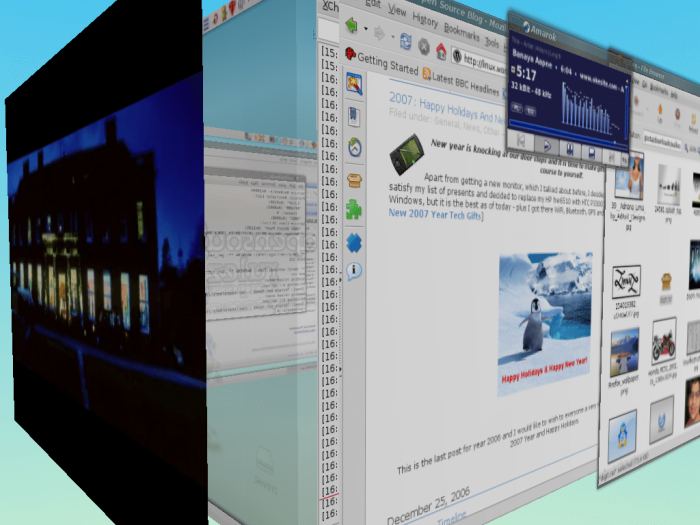Compiz is a compositing window manager that uses 3D graphics acceleration via OpenGL. It provides various new graphical effects and features on any desktop environment, including GNOME and KDE. Compiz has a flexible plug-in system and it is designed to run well on most graphics hardware.
The implementation of Compiz is based on using the new GLX_EXT_texture_from_pixmap extension of Xgl, AIGLX or NVIDIA for binding redirected top-level windows to texture objects.
Compiz brings to life a variety of visual effects that make the Linux desktop easier to use, more powerful and intuitive, and more accessible for users with special needs.
Compiz combines together a window manager and a composite manager using OpenGL for rendering. A “window manager” allows the manipulation of the multiple applications and dialog windows that are presented on the screen. A “composite manager” allows windows and other graphics to be combined together to create composite images. Compiz achieves its stunning effects by doing both of these functions.
Compiz receives official support from a number of leading Linux distributions.
Features include:
- Plugins:
- Annotate: draw things on top of all windows.
- Clone: duplicate output on two screens.
- Cube: each virtual desktop becomes a face on a cube.
- Decoration: a plugin to communicate decoration settings to a decorator.
- D-Bus: D-Bus interfacing.
- Fade: windows fade in and out.
- Gconf: settings come from GNOME.
- Ini: Text based configuration.
- Inotify: an inotify plugin which allows plugin developers to easily access inotify. It is currently used to notify settings programs when new plugins are added to the plugins directory.
- Minimize: windows minimize (and maximize/restore) with an animation effect.
- Move: window moving.
- Place: placement of new windows.
- Png: allows plugin developers to load PNG files as textures without worrying about the image format.
- Resize: window resizing.
- Rotate: the desktop cube can be rotated.
- Scale: an overview of all open windows (similar to Mac OS X’s Exposé).
- Svg: allows plugin developers to load svg files as textures. Other image plugins can be added so that extra image types will be seamlessly supported.
- Switcher: active window can be chosen with Alt-Tab.
- Video: accelerated video output.
- Water: ripples trailing mouse and rain effect.
- Wobbly: windows wobble while they move.
- Zoom: magnifies a part of screen.
- Conforms to the Inter-Client Communication Conventions Manual standard.
- Uses the Composite extension to X.
- Supports the OpenGL extension GLX_EXT_texture_from_pixmap.
Website: launchpad.net/compiz
Support: Mailing List
Developer: David Reveman, Danny Baumann, Dennis Kasprzyk, Matthias Hopf, Dave Arlie, Adam Jackson, Jon Smirl
License: GNU General Public License

Compiz is written in C++. Learn C++ with our recommended free books and free tutorials.
Return to Stacking Window Managers | Return to Compositing Window Managers | Return to Window Managers
| Popular series | |
|---|---|
| The largest compilation of the best free and open source software in the universe. Each article is supplied with a legendary ratings chart helping you to make informed decisions. | |
| Hundreds of in-depth reviews offering our unbiased and expert opinion on software. We offer helpful and impartial information. | |
| The Big List of Active Linux Distros is a large compilation of actively developed Linux distributions. | |
| Replace proprietary software with open source alternatives: Google, Microsoft, Apple, Adobe, IBM, Autodesk, Oracle, Atlassian, Corel, Cisco, Intuit, and SAS. | |
| Awesome Free Linux Games Tools showcases a series of tools that making gaming on Linux a more pleasurable experience. This is a new series. | |
| Machine Learning explores practical applications of machine learning and deep learning from a Linux perspective. We've written reviews of more than 40 self-hosted apps. All are free and open source. | |
| New to Linux? Read our Linux for Starters series. We start right at the basics and teach you everything you need to know to get started with Linux. | |
| Alternatives to popular CLI tools showcases essential tools that are modern replacements for core Linux utilities. | |
| Essential Linux system tools focuses on small, indispensable utilities, useful for system administrators as well as regular users. | |
| Linux utilities to maximise your productivity. Small, indispensable tools, useful for anyone running a Linux machine. | |
| Surveys popular streaming services from a Linux perspective: Amazon Music Unlimited, Myuzi, Spotify, Deezer, Tidal. | |
| Saving Money with Linux looks at how you can reduce your energy bills running Linux. | |
| Home computers became commonplace in the 1980s. Emulate home computers including the Commodore 64, Amiga, Atari ST, ZX81, Amstrad CPC, and ZX Spectrum. | |
| Now and Then examines how promising open source software fared over the years. It can be a bumpy ride. | |
| Linux at Home looks at a range of home activities where Linux can play its part, making the most of our time at home, keeping active and engaged. | |
| Linux Candy reveals the lighter side of Linux. Have some fun and escape from the daily drudgery. | |
| Getting Started with Docker helps you master Docker, a set of platform as a service products that delivers software in packages called containers. | |
| Best Free Android Apps. We showcase free Android apps that are definitely worth downloading. There's a strict eligibility criteria for inclusion in this series. | |
| These best free books accelerate your learning of every programming language. Learn a new language today! | |
| These free tutorials offer the perfect tonic to our free programming books series. | |
| Linux Around The World showcases usergroups that are relevant to Linux enthusiasts. Great ways to meet up with fellow enthusiasts. | |
| Stars and Stripes is an occasional series looking at the impact of Linux in the USA. | |
